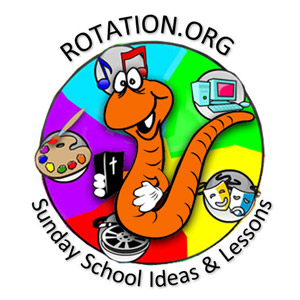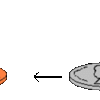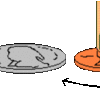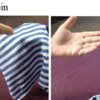Rotation.org Writing Team
Jacob and Esau
"Magic" Workshop
Summary of Lesson
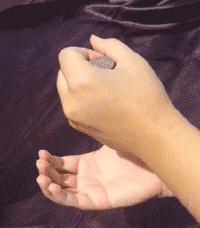 This particular workshop in the Writing Team's Jacob and Esau lesson set looks at the final episode in the Jacob saga — his reconciliation with Esau. It examines the scriptures for clues as to what actions Jacob took to show his desire for peace when they met.
This particular workshop in the Writing Team's Jacob and Esau lesson set looks at the final episode in the Jacob saga — his reconciliation with Esau. It examines the scriptures for clues as to what actions Jacob took to show his desire for peace when they met.
Students will learn to perform two magic tricks which help illustrate and emphasize key concepts in the Bible study. They will close with a "scenes from a hat" exercise that suggests the words and posture of one trying to make peace, and pray using one of the magic tricks to drive the lesson deeper into memory.
Because this lesson focuses on the end of Jacob's story, it is recommended that you teach it after the overview of his story has already been taught.
See age range note at the end of this lesson.
Pictured right: The secret to the vanishing coin trick.
Scripture
Genesis 33:1-11, the story of Jacob's reconciliation with Esau
Key Verse: "Please accept my gift that is brought to you, because God has dealt graciously with me...." (This is a different key verse than used in the Bible Background, but it emphasized the lesson's point: we can be gracious in making peace because God has been gracious with us.)
Objectives for the Rotation
See Bible Background.
Objectives for this Workshop
- Students will learn that making peace is more than saying words, it is action, it is how you approach the person and your tone.
- Students will practice how they might approach someone with whom they need to act graciously and make peace with.
- Students will understand that, like Jacob, the grace they are called to practice towards others — especially those they are in conflict with, reflect their appreciation for God's forgiveness and grace towards them.
Preparation
- Read the Bible Background, scriptures, and lesson plan.
- Gather supplies for each student.
- Review the movie of the "Vanishing Coin" trick at the bottom of this lesson post at rotation.org.
- Practice the two magic tricks until you are proficient at them.
To the Teacher:
This lesson appears long because we've made numerous suggestions of "what to say" during each demonstration and step. The opening below is written something like a script. In addition to instructions, it suggests what you should say as you're performing and instructing. Feel free to make it your own.
You will be demonstrating and then teaching your students how to perform two magic tricks that illustrate key ideas. Then you will be leading an interactive Bible study and helping them practice making peace.
After demonstrating each trick, take your time helping the students learn how to perform them themselves so that the lesson is memorable and can go home. Make sure you make a strong connection between the tricks and "the point" they are intended to illustrate. Remember to emphasize that we are to seek reconciliation with others because, like Jacob, we have been dealt with graciously by God. We forgive, because we are forgiven.
Supplies
- two pennies and one nickel for each student.
- a bandanna or similar size piece of fabric for each student.
- Bible(s)
Lesson Plan
Open
Welcome your students and tell them how the lesson will unfold today. They will learn two magic tricks and study the story of Jacob and Esau's reconciliation, Then they will play a fun "acting" game and conclude with a special prayer that repeats the second magic trick.
"The Impossible Coin Trick"
Say: Today, I am going to teach you how to do the impossible…
Give two pennies and a nickel to each student and have them place them on a smooth table with the pennies touching each other. Challenge the students to figure out “how to get the nickel between the two pennies” without breaking the following rules: One penny may not be moved. The other penny may not be touched by anything (other than the penny it is already touching). (Go ahead and let them try, and remember to enforce the rules!)
The Story
This coin trick seems impossible, doesn’t it? I want you to stop trying to solve it for a moment. I will teach you how to do the trick, but first, I want you to think about another “impossible” situation we have been learning about: Jacob stealing from his brother and lying to his father, the impossible, incredible reconciliation they will make at the end of the story.
How do you think Esau felt about his brother Jacob when he realized Jacob had not only stolen his inheritance, but also tricked his father to get the special blessing? (hate, anger, betrayal)
How do you think Esau felt about his mother Rebekah after he found out that she had helped Jacob steal his blessing and inheritance? (very angry, very betrayed… his own mother!)
If you didn’t know the end of the story, how impossible is it for this story of lying and betrayal to have a happy ending? (pretty impossible if we’re being honest) In the real world, one person might attack the other, or say bad things for a very long time, or never speak to them again.
So what turned Jacob the Deceiver and Liar into Jacob the Man who did the seemingly impossible: returned to his brother Esau to seek forgiveness?
First Clue: it didn’t happen right away, what things happened to Jacob after he fled from Esau?
Second Clue: God stepped into Jacob’s life in two big ways to change him. What were those two encounters?
I'm sure that Jacob wondered if it was possible to reconcile with Esau. After all, he had done him wrong!
Solution to the Coin Trick
What’s impossible for some, is not impossible if you know how to do it. Here’s how to do the seemingly impossible:
With the pennies touching each other, put your index finger on one penny. (This is “the penny which cannot be moved” per the rule.) Then place the nickel a few inches away from the penny you are holding down. Sharply slide the nickel towards the penny you are holding down. The force of the nickel will be transferred through the held penny to the one not being held, making it slide away. Do it hard enough to make it slide far enough away so that now the nickel can be slid between the pennies.
Teach your students how to do the trick until everyone can show it to each other.
Make the Point:
The seemingly impossible can be done if you know how to do it and if you try. While others probably thought Jacob and Esau could never make peace, something happened to Jacob's heart that made him want to try.
In your life, you may have enemies. You may have people who are jealous of you, or think you have taken something from them. You may have someone at school that hates you, or has been so mean to you that you think you can never make friends with them.
You may have a brother or sister you do not get along with. You may even have a parent who lets you down some day. But when you have God in your life, no situation is so broken that it can’t be fixed. When you have God in your life, making peace may be hard, but it is not impossible.
The “nickel between the penny trick” works because the nickel’s energy is transferred through the penny you are holding down and into the other penny, making it jump away. It’s impact is transferred from one penny to the next, allowing you to get enough space between the two pennies to place the nickel.
Now here's what the trick can teach us: You are the penny being held down. Held down by anger, guilt, shame, and holding a grudge. The “other” penny touching you is the person in your life that you need to make peace with. The nickel is God trying to affect both of you to make peace possible. If you are willing, God can act THROUGH YOU to not only affect you, but the person you are having the problem with.
Do the trick one more time thinking about that. The nickel is God, and the two pennies are you and all the people you will ever come in conflict with.
Next, we’ll look at WHAT JACOB ACTUALLY DID to make a seemingly impossible peace with his brother Esau.
Dig: What Jacob DID to make his seemingly impossible peace with Esau
Take turns reading Genesis 33: 1-11, then go back through it sharing the following comments and questions:
1 Now Jacob looked up and saw Esau coming, and four hundred men with him.
What would you do if you saw 400 men coming with your enemy? Why did Esau bring 400 men with him…what did he expect?
2 So he (Jacob) divided the children among Leah and Rachel and the two maids.2 He put the maids with their children in front, then Leah with her children, and Rachel and Joseph last of all.
Why did he divide up his family this way? (It shows that Jacob expected the worse, and put his dearest wife and son in the back to protect them. When seeking peace with someone, you must also be safe.)
3 He (Jacob) himself went on ahead of them, bowing himself to the ground seven times, until he came near his brother.
Have one of your students demonstrate bowing 7 times as they approach you.
4 But Esau ran to meet him, and embraced him, and fell on his neck and kissed him, and they wept.
How unexpected was this! What changed Esau’s heart toward Jacob?
5 When Esau looked up and saw the women and children, he said, “Who are these with you?” Jacob said, “The children whom God has graciously given your servant.” 6 Then the maids drew near, they and their children, and bowed down;
Sometimes when we are at “war” with someone, it is easy to forget that our enemy has a family too. They have feelings and troubles and responsibilities. Esau probably saw that his little brother had grown up and become responsible. Sometimes you need to see your enemy as someone who is more like you.
7 Leah likewise and her children drew near and bowed down; and finally Joseph and Rachel drew near, and they bowed down. 8 Esau said, “What do you mean by all this company that I met?”
Esau is astounded by this act of peacemaking, but he wants to hear it from Jacob himself, so he asks him to explain what all this means. To make peace, we often have to listen carefully to one another.
8 Jacob answered, “To find favor with my lord.”
Jacob calls his older brother “lord” ! This is an astounding admission that Jacob didn’t really own the birthright, he had only wrongly taken it. If you were trying to make peace with a friend or parents, what name could you call them that would be a great signal from your heart to theirs?
9 But Esau said, “I have enough, my brother; keep what you have for yourself.”
Where do you think Esau's generosity comes from? It was like a signal to Jacob that “I accept you.” It is good to be "generous" when settling old arguments. You do not have to agree on the details of what happened, only that none of the "he said, she said" is more important than making peace and showing respect. Trying to win the argument or assign blame usually doesn't make for peace, it only rekindles the bitterness.
10 Jacob said, “No, please; if I find favor with you, then accept my present from my hand; for truly to see your face is like seeing the face of God—since you have received me with such favor.
What effect would it have to tell someone you are fighting with that you want peace because you believe in God?
11 Please accept my gift that is brought to you, because God has dealt graciously with me, and because I have everything I want.” So he urged him, and he took it.
Jacob twice used the word “please,” and also “urged” Esau to take the gifts. What does that say about Jacob’s desire for peace?
Jacob also reveals the source of his gifts: God. What do you think Esau’s reaction would be to that?
On the surface of it, Jacob brought gifts of animals to his brother Esau, but what was the REAL GIFT he brought to his brother Esau? A desire for peace! A desire for reconciliation. Imagine how Esau felt when Jacob said that his face was like seeing the face of God. Surely this was Jacob's "I'm sorry."
The Vanishing Coin Trick
This is a really fun "sleight of hand" that's easy for kids to learn, and will be a great memory hook for this idea: we need to get rid of the grudges, anger, bad attitudes and embarrassments created by conflict in order to begin making peace. This is what Jacob and Esau did. They didn't bring their grudges, bring up the past, or play the blame game. Instead, they did some things to begin rebuilding their relationship.
See the video of this trick posted at the end of this lesson. You can also save it.
The trick:
Give each student a nickel. Have them practice putting the coin on the top of their closed fist (resting in the hole created by the index finger and thumb), and then slightly opening their fist to let the coin drop through their hand to their other hand below. See the graphic animation here ⇒
Now add the bandanna/cloth to the trick. Show them how to place the coin on the top of their fist, and then pull the bandanna up over their fist — and as they drag it over the top of their fist, and down behind their fist, they ever-so-slightly flex open their thumb to let the coin slide UNSEEN to their waiting open hand below. (Notice in the video posted at the end of this lesson how the finger grab the corner of the cloth so that the rest of the hand can slip under the hand above to catch the coin.) The bandanna is there to hide the coin AND to hide what your lower hand is quickly doing. The hand waiting below let's go of the bandanna after it pulls it over the fist and quickly slips below their other hand to catch the coin. Once secure in the hand, point that hand at the top of the cloth and ask the audience member to blow on it.
Have them practice this a few times without the bandanna, and then with the bandanna. Then have them practice having a friend BLOW on the bandanna to seemingly make the coin "disappear" (which it already has, having been dropped into your free hand), and then lift the bandanna with a flourish.
After practicing this a bit, add "the point" as you slowly demonstrate the trick once again. Have them follow along doing the trick with you as you say:
The Point: The coin represents the things that get in the way of having peaceful, forgiving relationships with each other. The coin is our bad attitudes, our grudges against one another, stewing over old wrongs, anger we still have, not wanting to forgive, or the shame and embarrassment we have because we know we've been wrong, but can't bring ourselves to admit it and seek forgiveness. (Offer some examples of things Jacob felt shame about, and things Esau probably felt angry about.)
Say: Do you think God wants us to hold onto all that? No. Can we find peace with ourselves or with our brother or sister or enemy if we keep thinking about who was right and wrong and who's better and who's bad? No. Truth is, none of us are perfect. We all need each other's forgiveness. We all need to give each other slack. Just as God has given each of us slack.
We need to get all those negative thoughts and behaviors out of the way in order to live together in real peace. (Now pull the bandanna over your coin).
The Bible says some interesting things about sin that look a lot like our demonstration here:
- In Romans 4 and 11, the Apostle Paul said, God covers your sins, and takes them away.
- In Isaiah 38, Isaiah says, God casts our sins behind his back. He's put them behind him.
- In Isaiah 43, he says, God makes your sins go away, he does not remember them.
Have everyone perform the trick at the same time. If you'd like, have everyone "repeat after you" quoting the scriptures above as they cover the coin and then pull away the bandanna.
(Magician's Note: You can add a lot of touches to this trick, including moving your hand to behind someone's ear to produce the coin, or slipping it in your pocket while they are blowing on the cloth.)
Practicing Peace "Things from a Hat"
This activity is similar to the improv sketch "Things from a Hat" seen on the popular comedy show, "Who's Line Is It Anyway." The teacher pulls a "situation slip of paper" from a hat, reads it, and students come forward to act out what's on the slip with the teacher. Each slip corresponds to something you want to teach your students about the words, actions, and body language of peace. (See the adaptations for a shorter version of this activity.)
Let several students come forward at the same time, pull out the slip and read it out loud. Read the teacher part for each student's turn. Slip #6 is the conclusion of the lesson.
As students act these out, make your comments: attitude, facial expressions, tone, posture reveal as much as your words. As we learned in the Bible study, Jacob had all the right tone and posture. Feel free to act out a few of these yourself!
Slip 1:
Teacher: Your friend caught you lying about not inviting them to your birthday party.
Student: You offer a really insincere and snotty apology for leaving them out.
Slip 2:
Teacher: "You know, what you said about me to our friends really hurt..."
Student: Apologize nicely for saying it, but use a totally insincere body language/posture that suggests you really don't mean your apology!
Slip 3:
Teacher: "You really are a jerk to me sometimes!"
Student: Say, "I know" and show you care by reaching out to them to show you care without saying another word.
Slip 4:
Teacher: "Jacob! Why after all these years are you coming back to apologize?"
Student: Explain yourself, Jacob! How God has changed you into a better person, and brought you back to make peace.
Slip 5:
Teacher: You are passing by your enemy in the hallway at school.
Student: Show a non-verbal way to say to the enemy, "I care about you."
Slip 6:
Teacher:
One of you show us show us the Penny-Nickel trick — explaining how God's spirit can move through us to make an impossible situation, like making peace with an enemy, possible with God's help!
One of you perform the disappearing coin trick — explaining that the quarter represents "hate" and "shame" and "grudges" and "anger" that we need to make go away if we are to have peace between us.
(If time, invite others to come forward and perform one of the two tricks while explaining it's meaning for our lesson today.)
Closing:
The teacher invites all the students to do as the teacher does:
1. Hold out your hand as if you're going to put a quarter in it for the trick.
2. Symbolically put your problems in your hand: problem with people, things you have done wrong, shame you feel for not being the person you should be, and anger at those who bring you pain. Then cover your hand with your bandanna.
3. Invite students to bow their heads with you, as they hold out their hand with the bandanna on it.
The Prayer:
Lord, we are not perfect.
We have made mistakes.
Other people have made mistakes with us that have left us angry or hurt.
People have been mean to us. We have been mean to other people.
People have taken things from us. We have taken things as well.
We pray that we will not hold on to these things, that we will let them go.
We pray that those whom we have hurt will not hold our sins against us.
We pray for relationships to be healed, and sins to be forgotten.
Help us all to see each other the way you see us: with loving and forgiving eyes.
Amen.
Additional Suggestions & Adaptations
A Simpler Version of the Disappearing Coin Trick
There is a simpler way to do this trick, and simpler way to teach children how to do it themselves. In the video, the magician is seen quickly wrapping the scarf or bandanna several times over his hand — which is too fast for children. Instead, as you lay the bandanna on top of your "quarter holding hand," while you pull the scarf over the top of your "quarter hand" from front to back, let your "scarf pulling hand" momentarily slip underneath your quarter holding hand so you can let the quarter drop into your waiting hand below.
Your audience will be distracted by the scarf, and not notice your thumb slightly moving to let the quarter drop into your waiting hand, and the draped scarf will block the sight of your hand slipping beneath.
Distract them further by telling them to blow on the top of the scarf to make the quarter disappear. As they are distracted by looking at and blowing on the scarf, you can slip the quarter into your pocket. Repeat the trick once by producing "another" quarter from your pocket (the same one!), only this time, when you catch the falling quarter and pull the scarf off your hand to show that the "quarter has disappeared!" ...you can then reach behind the audience member's ear with the quarter you have in your hand and act like you pulled it out of their ear. I've done this trick with children and adults hundreds of times, and they love learning how to do it themselves. ~Neil
Adaptations For Younger Children
I've taught the disappearing coin trick to five year olds. They don't do it well, but love trying! You'll need to simplify your language and concepts.
The Practicing Peace "slips" exercise could be a "simon says-like" activity, such as, "Simon says, act like you are mad, act like you care, act like you are forgiving someone, act kind, act like you are apologizing, act like Jacob bowing to Esau." etc.
Short on time?
Skip the opening three coins trick and go right to the Bible study.
Neil's Note on Using Magic Tricks in Sunday School
Magic tricks or sleight-of-hand demonstrations are object lessons. They are prop manipulations that focus the student's attention and provide a strong memory hook. When you teach the trick to the student, you are also invoking their kinesthetic intelligence, which is to say, their movement/manipulation/hands-on learning faculties.
In my opinion, magic tricks should never be used to with children teach about miracles, --water into wine, for example. You can find such tricks online. The problem is that they subliminally suggest to impressionable minds that miracles might be tricks or have some hidden explanation. Miracles are acts of God, not tricks.
Written by: Rev. Neil MacQueen for the Rotation.org Writing Team
Lesson copyright © 2015 by Rotation.org
Printed from https://www.rotation.org
Impossible Coin trick graphics courtesy of Garry Gardner,
www.professorwonder.com. Used with permission.
Vanishing Coin trick graphics and video copyright, Rotation.org
The Vanishing Coin Trick video:

The coin drops to your lower hand as you pull down the cloth over you hand, but the position of your lower hand is hidden to your audience.
See a fancy version of it on Youtube at https://youtu.be/f7xgGKjMrQM
